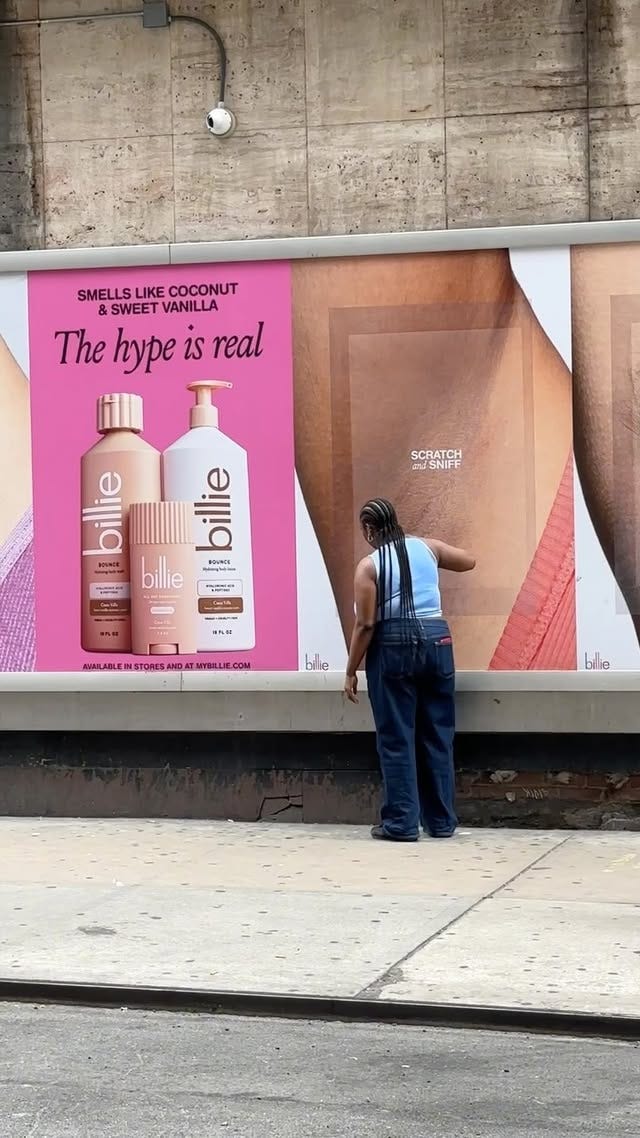Good morning! I hope you’re having a good week. I don’t know about you, but I am TIRED. I had been meaning to write this post all week, and then I spent most of last night flipping between the Karen Read docuseries on HBO (thanks
for the rec) and Pinterest, and all of a sudden it was late and I hadn’t written anything.But what I’ve been meaning to write – really ever since covering body care brand Billie’s scratch-and-sniff billboard in last week’s issue – is the rise of ads within ads through carefully-crafted authenticity among influencers.
This isn't a brand new tactic. As I wrote wayyy back in Issue #9, CeraVe executed this strategy well with their Michael Cera partnership last year, when they collaborated with creators like Haley Kalil, Bobbi Althoff, and Deuxmoi to generate speculation about whether Cera had actually founded CeraVe. The content had a gossip-like feeling to it, evolving what could have been traditional sponsored posts into a series of seemingly-organic posts that felt like insider information. Rather than promoting a product outright, the influencer content was promoting a marketing stunt, featuring the CeraVe product in turn.
Deuxmoi also did something similar back in February with this post featuring Charli D’Amelio that everyone was super confused about…
This content works so well to build buzz for brands because we've all become pretty good at identifying traditional influencer or sponsored content – and we’re also really good at swiping past it by this point. But when there's ambiguity about whether content is actually sponsored (like with Deuxmoi's post about Michael Cera), we're more likely to engage with it. In the case of Billie's out-of-home advertisement, the fact that WhatIsNewYork featured it created a sense of organic discovery. Since the account typically posts genuine, engaging content about the city, followers were less likely to recognize the post as branded content and dismiss it outright.
Of course, the entire premise of influencer content is for it to seem authentic, but this strategy takes it to a whole new level. This type of carefully-crafted authenticity blurs the lines between organic content and paid promotion, building buzz through what appears to be spontaneous coverage of a brand moment, campaign, or activation. Plus, it helps brands actually measure the reach of marketing tactics that are usually challenging to measure, like OOH campaigns.
So, when does it make sense to partner with influencers or meme accounts to create stealth marketing content to promote a campaign or moment?
When you’re building buzz around a marketing stunt or campaign. So let’s be clear: this tactic tends to work really well when you’re not directly advertising a product or service through fake UGC/influencer content, but when you’re actually advertising an advertisement (meta, I know). The key here is that your marketing campaign or stunt must be interesting enough to warrant genuine buzz from an influencer account. Ask yourself: even if you didn’t sponsor the content, would an account like WhatIsNewYork feasibly cover your OOH creative in a social post? If the answer is yes – like it was for Billie – then run with it.
When the content creates a cultural moment or generates a conversation – instead of just repeating a marketing message. The most successful examples of this marketing strategy created a genuine conversation that people wanted to talk about. The Michael Cera/CeraVe drama wasn't really about CeraVe—it was about solving an entertaining mystery. Sure, the name similarities were smart, but the content would have been engaging regardless of the brand.
When there's alignment between the influencer’s audience and content style. WhatIsNewYork featuring Billie’s eye-catching billboard made so much sense because the account’s area of expertise is highlighting weird sights in the city. Because Billie’s billboard was a natural fit for their feed, audiences were probably more likely to engage with the post without questioning whether it was sponsored.
But what do you think? Do you find this strategy to be innovative and smart, or does it just end up blurring the lines between organic and paid content and feel deceiving?
Also, have you seen any other examples of this type of promotional tactic out in the wild? Let me know!







feels like a way for brands to ride off of the "build with us", "behind the scenes" tactic when it reality you're not really getting any extra peak into anything lolz but I think it attempts to humanize it all during a time when consumers crave some sense of reliability. Word vomit sorry.